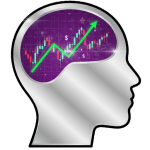Eliminate Doubt Trading: Proven Techniques to Quiet Your Mind & Maximize Returns
What is Doubt Trading & Why Does it Happen?
Doubt trading is the insidious enemy of consistent profitability. It’s when uncertainty and fear hijack your decision-making process, leading to impulsive, often detrimental trades. Instead of sticking to a well-defined strategy, you second-guess yourself, deviate from your plan, and ultimately, sabotage your potential gains.
But why does this happen? Trading inherently involves risk. The very nature of markets — their volatility and unpredictability — breeds anxiety. This anxiety, if left unchecked, morphs into doubt. We crave certainty in an uncertain environment, and when that certainty is absent, our minds fill the void with worst-case scenarios, compelling us to act irrationally.
Doubt often stems from a lack of confidence in one’s trading system, insufficient knowledge, or past trading losses that linger in the memory, casting a shadow over future decisions. Ultimately, doubt trading is trading led by fear and emotion, not logic and strategy.
Common Psychological Triggers for Doubt in Trading
Identifying the triggers that set off doubt trading is crucial for controlling it. Several common psychological factors contribute:
- Fear of Loss: This is perhaps the biggest culprit. The pain of losing money can be intensely emotional, leading to hesitation and risk aversion even when an opportunity aligns perfectly with your strategy.
- Greed: The desire for quick profits can cloud judgment. Instead of adhering to your plan, you might chase unrealistic gains, ignoring warning signs and increasing your risk.
- Overthinking: Analyzing the same data repeatedly without making a decision traps you in a cycle of doubt. You become paralyzed by indecision, missing potentially profitable trades.
- Lack of Confidence: A shaky belief in your strategy or your own abilities breeds doubt. This can stem from insufficient preparation, limited experience, or a series of losing trades.
- External Opinions: Listening to the opinions of others, especially on social media or trading forums, can introduce conflicting viewpoints and undermine your confidence.
How to Identify and Acknowledge Doubtful Thoughts
The first step to overcoming doubt is recognizing it. Start by paying attention to your inner dialogue. Are you constantly questioning your decisions? Do you feel anxious or stressed before placing a trade? Are you easily swayed by external opinions? These are red flags.
Keep a trading journal. Write down not only the details of your trades but also your thoughts and feelings before, during, and after each one. This helps you identify patterns and triggers that lead to doubt. Ask yourself:
- What specific thoughts or worries are affecting my decision?
- Am I deviating from my trading plan? If so, why?
- Am I acting out of fear or greed?
- Am I truly confident in my analysis, or am I just hoping for the best?
Once you identify these thoughts, acknowledge them without judgment. Don’t try to suppress them or tell yourself you shouldn’t feel that way. Simply recognize that they are there and that they are influencing your decisions.
Developing a Robust Trading Plan to Combat Doubt
A well-defined trading plan is your shield against doubt. It provides a framework for making rational decisions, reducing the emotional component of trading. Your plan should include:
- Clear Objectives: What are your goals? How much profit are you aiming for? What is your risk tolerance?
- Specific Entry Criteria: What conditions must be met before you enter a trade? This should be based on technical or fundamental analysis, not gut feeling.
- Exit Strategy: Where will you take profits? Where will you cut your losses? Predefining these levels removes the temptation to hold onto losing trades or prematurely exit winning ones.
- Position Sizing Rules: How much of your capital will you risk on each trade? This should be based on your risk tolerance and the volatility of the market.
- Record Keeping: Keep detailed records of all your trades, including the reasons for entering and exiting, the results, and your emotional state.
Having a clear and well-documented plan provides a roadmap for making decisions in real-time, reducing the room for doubt to creep in.
The Importance of Backtesting and Paper Trading
Backtesting and paper trading are invaluable tools for building confidence in your trading plan. Backtesting involves applying your strategy to historical data to see how it would have performed in the past. Paper trading, or simulated trading, allows you to practice your strategy in real-time without risking real money.
These practices help you:
- Validate Your Strategy: Does your plan actually generate profits? Backtesting provides quantifiable results, while paper trading allows you to assess its real-world applicability.
- Identify Weaknesses: Backtesting and paper trading can reveal flaws in your strategy, allowing you to make adjustments before risking real capital.
- Build Confidence: Seeing your strategy perform well, even in a simulated environment, can significantly boost your confidence and reduce doubt.
- Develop Your Skills: Practice makes perfect. The more you use your strategy, the more comfortable and confident you will become.
Risk Management Strategies to Minimize Emotional Impact
Effective risk management is essential for controlling doubt because it limits the potential for significant losses, which can trigger strong emotional reactions. Key strategies include:
- Stop-Loss Orders: Always use stop-loss orders to automatically exit a trade if it moves against you. This limits your potential losses and prevents you from holding onto losing trades out of hope or fear.
- Position Sizing: Never risk more than a small percentage of your capital on any single trade. A common rule is to risk no more than 1-2%.
- Diversification: Don’t put all your eggs in one basket. Diversify your portfolio across different assets and markets to reduce your overall risk.
- Risk/Reward Ratio: Aim for a favorable risk/reward ratio. For example, if you’re risking $1 to potentially make $2, you can afford to be wrong more often and still be profitable.
By implementing these strategies, you create a buffer against large losses and minimize the emotional turmoil that can lead to doubt trading.
Mindfulness & Meditation Techniques for Traders
Mindfulness and meditation can help you develop greater self-awareness and emotional control, crucial for eliminating doubt trading. These practices allow you to observe your thoughts and feelings without judgment, enabling you to respond to them more rationally.
Simple mindfulness exercises include:
- Focused Breathing: Pay attention to your breath as it enters and leaves your body. When your mind wanders, gently redirect your attention back to your breath.
- Body Scan Meditation: Focus your attention on different parts of your body, noticing any sensations without judgment.
- Mindful Observation: Observe your thoughts and feelings as they arise, without getting carried away by them. Simply acknowledge them and let them pass.
Regular practice of these techniques can help you become more aware of your emotional state while trading, allowing you to recognize and manage doubt before it impacts your decisions.
Creating a Positive Trading Environment
Your trading environment can significantly impact your mindset. A cluttered, stressful environment can amplify anxiety and doubt, while a calm, organized environment can promote clarity and focus.
Consider these tips:
- Dedicated Workspace: Designate a specific area solely for trading. Keep it clean, organized, and free from distractions.
- Comfortable Setup: Ensure your chair, monitor, and lighting are ergonomically sound to minimize physical discomfort.
- Minimize Distractions: Turn off notifications, silence your phone, and let your family or housemates know you need uninterrupted time.
- Positive Affirmations: Display positive affirmations or motivational quotes to reinforce your confidence and focus.
A well-designed trading environment can help you maintain a positive and focused mindset, reducing the likelihood of doubt trading.
Seeking Support from a Trading Community or Mentor
Trading can be a lonely endeavor, and isolation can exacerbate doubt. Connecting with other traders can provide valuable support, perspective, and encouragement.
Consider these options:
- Online Trading Communities: Join online forums or social media groups dedicated to trading. Share your experiences, ask questions, and learn from others.
- Trading Mentors: Find an experienced trader who can provide guidance, feedback, and support. A mentor can help you identify your weaknesses, refine your strategy, and build your confidence.
- Local Trading Groups: Attend local trading meetups to connect with other traders in your area.
Sharing your challenges and successes with a supportive community can significantly reduce the burden of doubt and provide valuable insights.
Reviewing & Adjusting Your Strategy Based on Performance
Your trading strategy should be a living document, constantly evolving based on your performance and market conditions. Regularly review your trades, analyze your results, and identify areas for improvement.
Ask yourself:
- Is my strategy still working?
- Are there any patterns in my losing trades?
- Am I consistently following my trading plan?
- Are there any external factors that are affecting my results?
Based on your analysis, make adjustments to your strategy as needed. This might involve refining your entry criteria, modifying your exit strategy, or adjusting your position sizing rules. Continuous improvement is crucial for maintaining confidence and eliminating doubt.
How to Separate Emotions from Trading Decisions
Emotions are the enemy of rational trading. Learning to separate emotions from your decisions is paramount to eliminate doubt trading. Emotions like fear, greed, excitement, and regret can lead to impulsive and irrational actions.

To manage emotions effectively:
- Acknowledge and Label: Recognize the emotion you’re feeling (e.g., fear, greed) and name it. This helps you distance yourself from it.
- Understand the Trigger: Identify what caused the emotion. Was it a losing trade? A sudden market movement?
- Challenge the Thought: Question the validity of the thought that triggered the emotion. Is it based on facts or assumptions?
- Reframe the Situation: Look at the situation from a different perspective. Focus on the long-term goals rather than the short-term fluctuations.
- Stick to Your Plan: The best way to resist emotional impulses is to adhere to your well-defined trading plan.
Remember, the goal is not to eliminate emotions entirely but to prevent them from dictating your trading decisions.
Staying Disciplined: Sticking to Your Trading Rules
Discipline is the cornerstone of successful trading. Sticking to your trading rules, even when it’s difficult, is essential for eliminating doubt trading. Lack of discipline leads to impulsive decisions, deviations from your plan, and ultimately, losses.
Here’s how to cultivate discipline:
- Understand Your Rules: Have a clear understanding of your trading plan and the rationale behind each rule.
- Write Them Down: Keep a written copy of your trading rules easily accessible.
- Visualize Success: Visualize yourself following your rules and achieving your trading goals.
- Accountability: Partner with a trading friend or mentor who can hold you accountable.
- Reward Yourself: Celebrate milestones achieved by sticking to your plan.
Discipline is a muscle that gets stronger with practice. The more you stick to your rules, the easier it will become.
The Role of Self-Confidence in Eliminating Doubt
Self-confidence is the foundation upon which successful trading is built. When you believe in yourself and your abilities, doubt fades away. While some people are naturally more confident, self-confidence in trading is primarily built on knowledge, preparation, and experience..
Self-confidence comes from:
- Thorough Preparation: The more you know about the markets, the more confident you’ll be.
- Proven Strategy: Use backtesting and paper trading to validate your strategy.
- Positive Results: Consistent small wins breed feelings of positive self-regard.
- Acknowledging Strengths: Identify what you’re good at and capitalize on your strengths.
- Learning from Mistakes: View losses as learning opportunities.
Remember, self-confidence is not about being arrogant or overconfident; it’s about having a realistic assessment of your abilities and a belief in your potential for success.
Practical Exercises to Build Trading Confidence
Building trading confidence takes practice. Here are some exercises to specifically target confidence-building:
- Trade Small: Start with very small position sizes to reduce the emotional impact of losses.
- Focus on Process: Instead of obsessing over profits, concentrate on consistently following your trading plan.
- Celebrate Small Wins: Acknowledge and appreciate every successful trade, no matter how small.
- Review Winning Trades: Analyze your successful trades to understand what you did right.
- Journaling: Note your confidence levels while trading in your journal before and after trades.
Consistency is key. Regularly practice these exercises to gradually build your trading confidence.
Recognizing and Avoiding Cognitive Biases
Cognitive biases are systematic errors in thinking that can distort your perception of reality and lead to poor trading decisions. These biases often contribute to doubt and emotional trading.
Common biases to watch out for include:
- Anchoring Bias: Over-relying on initial information, even if it’s irrelevant.
- Confirmation Bias: Seeking out information that confirms your existing beliefs and ignoring conflicting evidence.
- Availability Heuristic: Overestimating the likelihood of events that are easily recalled (e.g., recent news).
- Loss Aversion: Feeling the pain of a loss more strongly than the pleasure of an equivalent gain.
- Gambler’s Fallacy: Believing that past events can influence future random events.
Before placing a trade, ask yourself if any of these biases might be influencing your decision. Actively seeking out alternative viewpoints and challenging your assumptions can help you mitigate the impact of cognitive biases.
Long-Term Strategies for Maintaining a Doubt-Free Mindset
Eliminating doubt trading is not a one-time fix; it’s an ongoing process. Here are some long-term strategies for maintaining a doubt-free mindset:
- Continuous Learning: Stay up-to-date on market trends and trading techniques.
- Regular Review: Periodically review your trading plan and make adjustments as needed.
- Mindfulness Practice: Continue practicing mindfulness and meditation to maintain emotional control.
- Community Engagement: Stay connected with other traders for support and encouragement.
- Maintain a Healthy Lifestyle: Get enough sleep, eat a balanced diet, and exercise regularly. Stress and fatigue can negatively impact your mindset.
By making these strategies part of your daily routine, you can cultivate a resilient and doubt-free mindset that will serve you well in the long run.
What are the signs of doubt trading affecting profitability?
Identifying whether doubt trading is impacting your profits is a crucial step in addressing the issue. Here are some telltale signs:
- Inconsistent Results: Fluctuating profits despite sticking to your trading strategy might indicate internal conflict is messing your wins
- Prematurely Closing Winning Trades: Closing positions early due to fear of losing profits, resulting in missed opportunities for larger gains.
- Holding Losing Trades Too Long: Avoiding taking losses because you’re hoping the market will turn around, leading to bigger losses.
- Frequent Strategy Changes: Bouncing between different strategies without giving them enough time to prove themselves, indicating a lack of confidence.
- Increased Stress and Anxiety: Feeling constantly stressed and anxious about your trades, suggesting that emotions are driving your decisions.
Closely monitoring these signs can help you identify and address the impact of doubt trading on your profitability.
How does fear of loss contribute to doubt trading?
Fear of loss is a powerful emotion that can significantly contribute to doubt trading. It can manifest in various ways, leading to poor decision-making and sabotaging potential profits.
Here’s how fear of loss fuels doubt trading:
- Hesitation: Freezing during high-conviction trades when your system signals and being a bystander
- Deviation from Strategy: Allowing fear to override your trading rules, leading you to deviate from your well-defined plan
- Reduced Position Sizes: Diminishing the value of your trades to protect your portfolio, but thereby shrinking potential profits
- Increased Risk Aversion: Avoid taking potentially profitable trades altogether.
Remember that loss is an inevitable part of trading. Managing your fear of loss is essential for making rational decisions and minimizing the impact of doubt on your performance.
Can journaling help eliminate doubt trading?
Yes, journaling is a powerful tool for eliminating doubt trading. By regularly reflecting on your thoughts, feelings, and actions, you can gain valuable insights into your trading psychology and identify patterns of doubt.
Here’s how journaling can benefit you:
- Self-Awareness: Discover what triggers you to make bad trades
- Emotional Regulation: Document how you feel when trading so you can get a better handle on fear, greed, or impulse
- Strategy Tracking: Make sure you’re sticking to your strategy, and when you’re not, discover why
- Confidence Building: Track your progress, build positive trading process and boost your morale when things get tough
Make journaling a ritual to help you become a self-aware and data-driven trader.
What key performance indicators (KPIs) should traders track to monitor doubt’s impact?
Tracking key performance indicators (KPIs) is essential for monitoring the impact of doubt on your trading performance. By analyzing these metrics, you can identify areas where doubt is negatively affecting your results and take corrective action.
Here are some KPIs to track:
- Win Rate: The percentage of winning trades versus losing trades. A significant drop in win rate might indicate doubt is affecting your decisions.
- Average Win/Loss Ratio: The average profit on winning trades compared to the average loss on losing trades. If this ratio decreases, it could mean you’re cutting winners short and letting losers run.
- Profit Factor: The ratio of gross profit to gross loss. A declining profit factor suggests that losses are outweighing gains.
- Number of Trades Taken: An unusually high or low number of trades could indicate impulsive behavior driven by fear or greed.
- Adherence to Trading Plan: The percentage of trades that follow your defined trading rules. A decrease in adherence suggests doubt is causing you to deviate from your plan.

